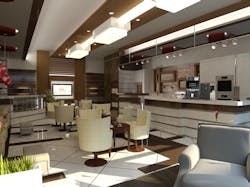Progressive businesses are getting the message about breakrooms. These spaces need to be redesigned to promote networking, collaboration, refueling physically, and creating a positive corporate culture. Coffee, related products, and those who deliver them, are right in the center of this revolution.
Showcasing the brewer
The fact that Millennials bring an appreciation of the coffeeshop with them to the workplace has influenced what the new breakroom looks like. The most well designed mimic the clean, open spaces of cafes with windows as well as tables and lounging areas. The coffee becomes a main attraction. The brewer is not set in a quiet corner, but put on display. Specialty coffee brewers, especially espresso machines are highly appreciated. According to 2016 National Coffee Association (NCA) data, 94 percent of people with an espresso machine at work were very/somewhat satisfied. Nearly 10 percentage points less, 86 percent said the same about drip coffee brewers.
Specialty beverages are really growing the office coffee segment in these redesigned break areas. Machines that make lattes, cappuccinos and flavored gourmet beverages with solubles are valued. The perception of these drinks is often higher among consumers than traditional, plain coffee, regardless of roast or sometimes bean quality. NCA found an increase in consumers opting for espresso-based beverages which includes cappuccino, espresso, latte, café mocha, macchiato, flat white and caffè Americano. It increased to 18 percent of the cup share, double what it was in 2011.
Some of this equipment really adds to the atmosphere with similar sights, smells and sounds of the coffeeshop. The bean-to-cup machines are enjoying popularity in cafe style breakrooms because the sight of the beans, sound of the grinder and smell of fresh coffee reminds employees of a quality cafe experience. Millennials especially value experience. Being able to interact with the coffee brewer to create a drink as well as experience the coffeeshop atmosphere has high appeal for this demographic.
Cold brew in many forms
In a class by itself is cold brew, another growing trend. Produced by coffee that has been steeped in cold or room temperature water for 12 or more hours, it is smooth with a lower acidity than traditionally brewed coffee. Subtleties in flavor also arise. Since this drink became popular a few years ago, traditional OCS operators have struggled with how to bring it to the workplace since it needs to be refrigerated and has a short shelf life. Early adopters offered it in growlers and kegs. Others started using bottled options that could be placed in coolers and were ready to drink. Some even sell the filter and coffee to locations with a “cold brew pitcher,” so the office staff can make cold brew themselves. NCA data shows cold brew consumption, past day, at 3.4 percent and our own State of the Office Coffee Service Industry data shows 31 percent of operators are providing it in some form, up from 25 percent in 2015.
There are more elements that make up the new workplace breakroom, but at its heart is coffee, the drink that has been associated with workplaces for decades, perhaps longer. Focus on getting the coffee right for the demographic, and the rest will follow. This is the modern age of coffee service, where being part of the breakroom means more than a brewer on the counter. Instead, it’s a partnership between the OCS operator and the location to set a tone to attract and retain employees.
3 OCS extensions for the modern break room
1. Let them eat
Add-ons to the new workplace cafe are welcomed by employees, enhancing the experience and appreciation for the service. Operators in areas of California, Illinois, Alabama, Kansas, etc. report great success adding snacks and other beverages to this new, coffee-focused workplace concept. For many it's healthy snacks, like nuts and granola. For others, it's an entire mini kitchen worth of food paid for by the company. The solution should be scaleable.
2. Provide natural hydration
Water especially is an area OCS operators are using to branch out. The point of use water filtration system have become affordable for locations that couldn't afford 5 gallon systems, or opted for a solution with less transport and storage hassles. The IBWA reports that the volume of home and office delivery "...slipped from close to 1.4 billion gallons in the early 2000s to 1.3 billion gallons in 2015, when volume moved up by 4.1 percent." Water has been increasingly popular for it's lack of artificial ingredients and its perception of a healthful alternative to other beverages, said IBWA. While not strictly water service, PET bottled water has been trending upwards in consumption as well.
3. Modernize the experience
Technology is also starring in this breakroom. It is the video screens on brewers that tell the story of the coffee roaster and the touchscreens that assist users in building their idea hot beverage. These brewers report issues to operators and prompt users to clean or perform small maintenance tasks. Don't miss the opportunity to offer technology in personalizing water either, with units that allow different levels of carbonation into sparkling water as well as some with flavors.
About the Author

Emily Refermat
Emily Refermat began covering the vending industry in 2006 and served as editor of Automatic Merchandiser from 2012 to 2019. To reach the current editor of Automatic Merchandiser and VendingMarketWatch.com, email [email protected].
